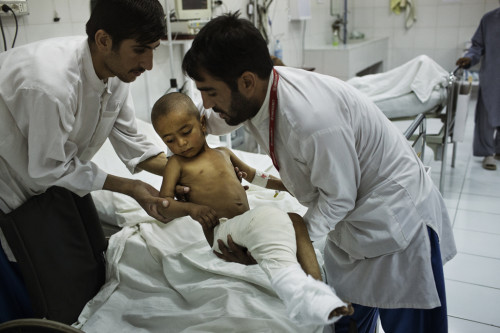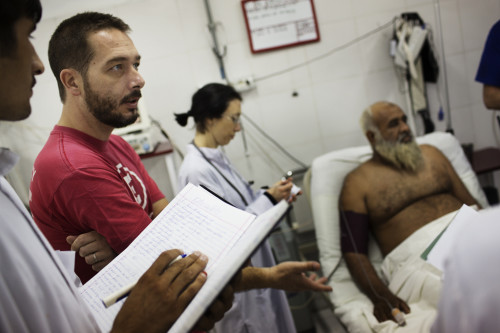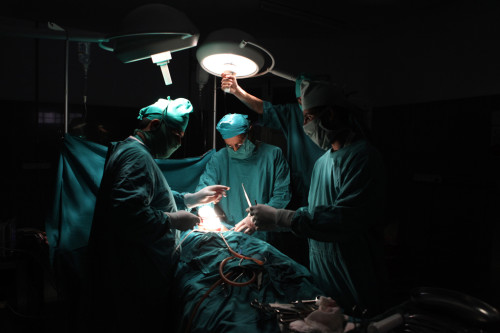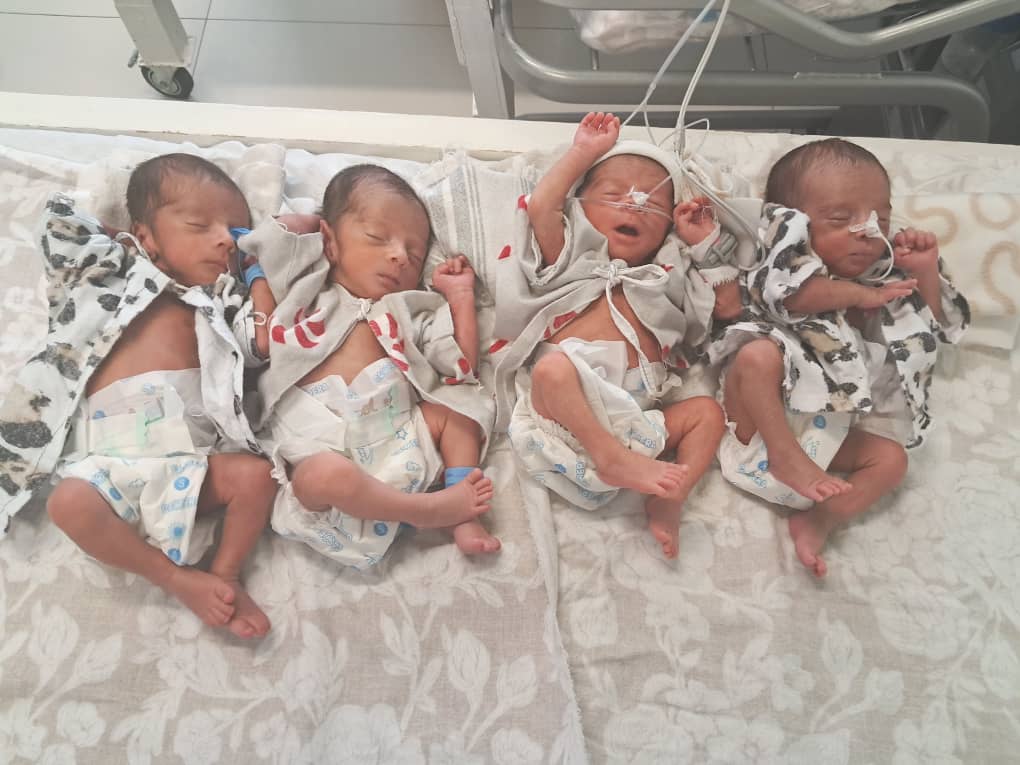Mahsa, Mehruma, Mehran, Mahnaz These four babies are siblings - quadruplets who were recently born…

AFGHANISTAN: Bringing humanity to the Helmand frontline
Lashkar-Gah, Afghanistan: Bringing humanity to the Helmand frontline
The following article is taken from the United Nation’s Office for the Coordination of Humanitarian Affairs’ (UN OCHA) Humanitarian Bulletin, which featured EMERGENCY’s Surgical Centre in Lashkar-gah, Afghanistan. Click here to read the original.
 Kafia was in her kitchen cooking when a rocket struck her home in Helmand Province’s Marja District. With no clinic in her village, her father had to whisk his 20-year-old daughter to EMERGENCY’s surgical centre in Lashkargah.
Kafia was in her kitchen cooking when a rocket struck her home in Helmand Province’s Marja District. With no clinic in her village, her father had to whisk his 20-year-old daughter to EMERGENCY’s surgical centre in Lashkargah.
“I received good treatment. I feel better now,” says the young woman.
Bibi, 25, also was injured in her home following a rocket attack in Sangin, one of Helmand Province’s most contested districts.
“I was lucky because there is a first aid post (FAP) in Sangin and they rescued me. After I received first aid treatment, I was transferred to EMERGENCY’s surgical centre in Lashkargah,” recalls Bibi.
Casualties continue to increase from ‘brutal’ Helmand Province conflict
The international non-governmental organization EMERGENCY opened the Lashkargah surgical centre in 2004 to provide specialized surgical services free of charge to victims of war in the embattled Province of Helmand, where Taliban and Afghan and foreign forces have waged some of Afghanistan’s fiercest and most deadly battles.
As the violence in Helmand Province escalates and intensifies becoming “more and more brutal,” the number of patients treated for war-related injuries from mines, shrapnel and bullets increases, says EMERGENCY Programme Coordinator Luca Radaelli, who has worked with the NGO in Afghanistan since 2008.
 “Helmand Province is very dangerous. We only observe a lull in fighting during poppy harvesting season, which takes place two or three times a year,” he notes. Roughly the same number of patients are treated in the Lashkargah facility as EMERGENCY’s surgical centre in the Afghan capital of Kabul, Radaelli points out to stress the scale of the ongoing armed conflict in Helmand and its impact on the local population.
“Helmand Province is very dangerous. We only observe a lull in fighting during poppy harvesting season, which takes place two or three times a year,” he notes. Roughly the same number of patients are treated in the Lashkargah facility as EMERGENCY’s surgical centre in the Afghan capital of Kabul, Radaelli points out to stress the scale of the ongoing armed conflict in Helmand and its impact on the local population.
Frontline FAPs reinforce neutrality policy
EMERGENCY’s presence in Afghanistan dates back to December 1999. Establishing its operations in the country has not always been easy, even though the public hospitals that exist in the country are inadequate to meet the medical needs of those in remote locations, and particularly so in areas where security is tenuous.
The NGO adheres to a policy of strict neutrality in the provision of its medical services. “We realized, after opening our first hospital in Panjsher in 2000, that to be neutral and to treat everybody without discrimination, our presence was needed in a valley under Northern Alliance control. The first step was to open a FAP close to the front line in order to bring victims over the front line to our facility in Panjsher. A clinic was not enough and so we opened a hospital in Kabul city, which at that time was under the control of the Taliban. In 2001, we had two fully functional hospitals located in areas controlled by both sides of the conflict,” explains Radaelli.
EMERGENCY has a network of six FAPs that operate 24 hours a day seven days a week in the remote Helmand Province villages of Grishk, Garmser, Marja, Sangin, Musaqalah and Urmuz link to the Lashkargah facility.
“About 70 per cent of patients treated at the Lashkargah facility are referred from FAPs, which shows the system is working,” adds Radelli. “We triage according to medical need and not nationality. Afghan civilians are not discharged to make space for soldiers. We never get involved in politics and we have no interest in knowing which side of the conflict a patient fights on,” stresses Radaelli.
“Our only interest is treating the injury and understanding its source. If it’s an ongoing conflict, we want to know so we can make preparations based on how many patients to anticipate.”
Local community helps manage and operate all facilities
 EMERGENCY has won the trust and respect of the local population through its reputation for providing the highest quality medical treatment available in the country, in a neutral and responsible manner, and its steadfast refusal to compromise on standards for quality.
EMERGENCY has won the trust and respect of the local population through its reputation for providing the highest quality medical treatment available in the country, in a neutral and responsible manner, and its steadfast refusal to compromise on standards for quality.
“I expect our facilities in Afghanistan to be of the same standard as a medical facility in Europe where I would take my own son or mother to be treated,” says Radaelli, adding that at 4 per cent the mortality rate for trauma patients treated in EMERGENCY facilities in Afghanistan is similar to the average mortality rate registered in Italian hospitals. EMERGENCY also involves local elders in the management and operation of all of its facilities.
“Any time we establish a facility, it has to be at the request of the local community. Following a thorough analysis, we choose site that will best benefit everyone in the community. Once we receive a request for a facility, we inform the local authorities. The local community provides a building, which is refurbished and converted into a medical facility,” explains Radaelli.
Staff undeterred by bullets and bombs
Each FAP includes a pharmacy and an ambulance. Each FAP is staffed by a total of six nurses and two cleaners and each ambulance is staffed by a driver and nurse, who are available to transport patients requiring life-saving medical treatment to the Lashkargah surgical centre.
EMERGENCY first became active in Afghanistan at a time when it was still customary for most Afghans to transport the sick or wounded in the trunk of their car. Ambulances were a revolutionary concept. Personnel who staff the NGO’s frontline FAPs in Sangin and Musaqalah are routinely required to work from a bunker to avoid being caught in crossfire. Radaelli is proud of the dedication of EMERGENCY’s Afghan staff who are committed to serving the people of Afghanistan under unimaginably adverse and life-threatening circumstances.
“They remain committed and keep working even when bullets are flying over their heads and bombs are exploding around them.” But it is the “beauty” of humanity that Radaelli routinely witnesses at the Lashkargah that impresses him even more.
“We see enemies from the battlefield lying side by side in their hospital beds and by creating an environment of trust, we can rebuild relationships that have been destroyed by conflict,” says Radaelli.




